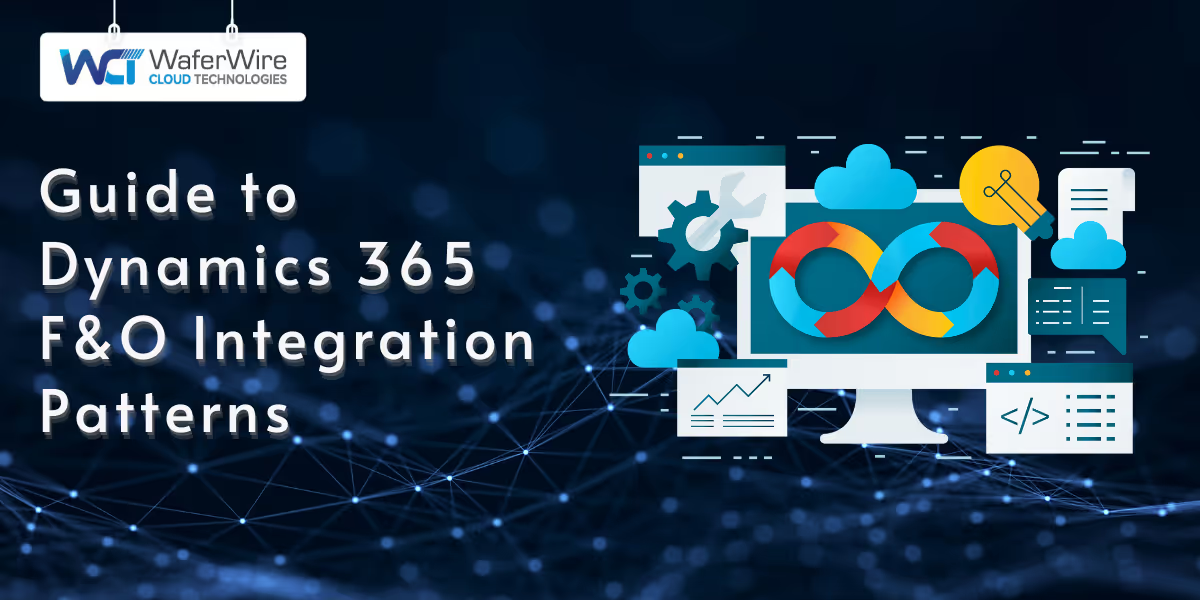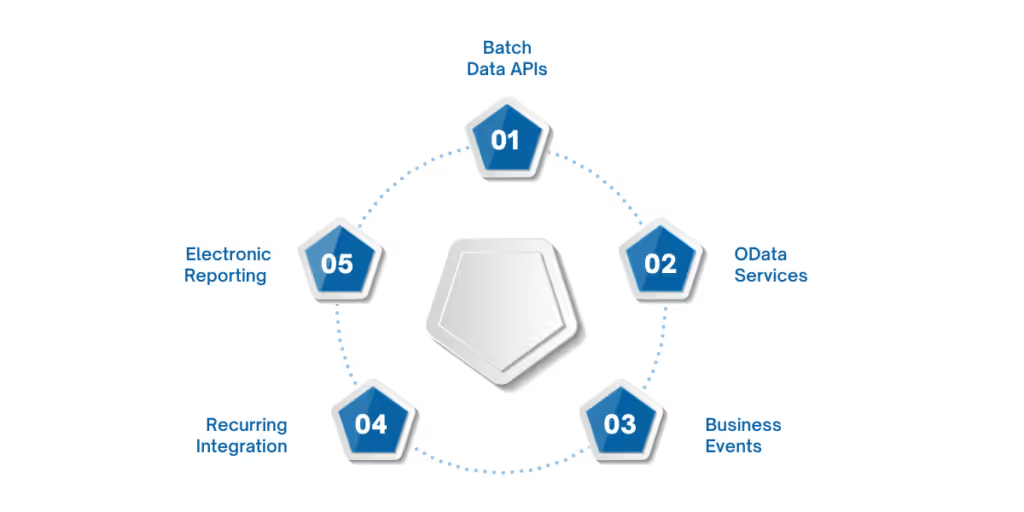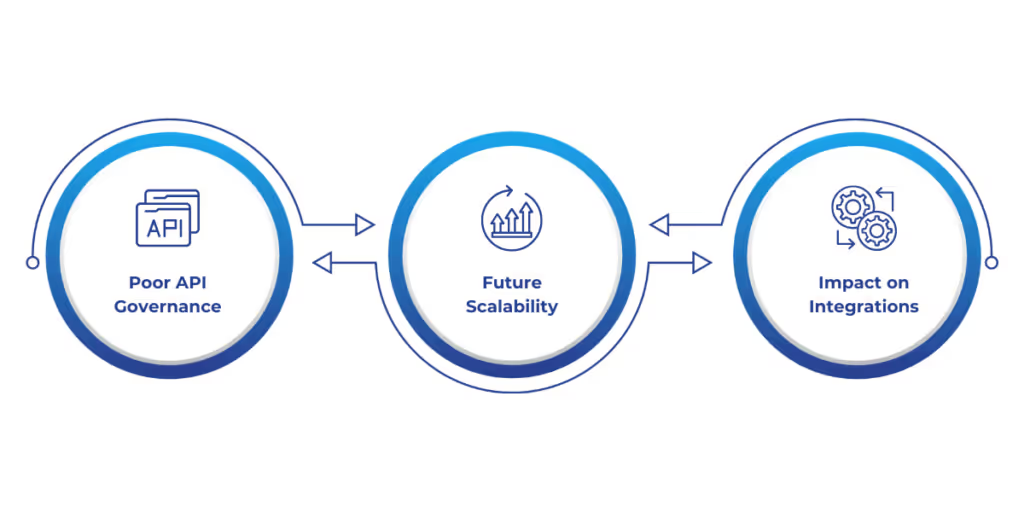

As modern enterprises operate across interconnected systems, seamless integration with other platforms, whether internal tools, legacy applications, or cloud-based services, is critical to maintaining operational efficiency and agility.
Whether you’re synchronizing product information with e-commerce platforms, automating purchase order flows with vendors, or pulling financial data into reporting dashboards, the right integration pattern can make or break your success.
Dynamics 365 Finance & Operations (D365 F&O) is Microsoft’s flagship Enterprise Resource Planning (ERP) solution, designed to support global financial management, supply chain operations, and business process automation.
This guide is designed to help architects, developers, and IT decision-makers understand the core integration patterns available in Dynamics 365 F&O.
Before diving into specific techniques, it’s essential to understand what integration in D365 F&O truly entails.
The D365 F&O integration refers to the ability to exchange data and trigger business processes between F&O and other systems both within and outside the organization. This ensures that disparate applications work in harmony to deliver a unified, efficient enterprise experience.
In D365 F&O, integration typically involves:
These integrations can be real-time, near-real-time, or batch-based, depending on the business requirement, system capabilities, and latency tolerance.
Some common integration use cases include:
These scenarios illustrate the growing need for D365 F&O to function as a hub in an enterprise’s digital ecosystem.
With this foundational knowledge, we can now explore the integration patterns available in D365 F&O and how each one fits different business requirements.

D365 F&O offers multiple integration approaches, each suited for specific use cases. Choosing the right pattern depends on a variety of factors. Below is a breakdown of the major integration patterns used in D365 F&O:
The Data Management Framework (DMF) supports data import and export through entities using batch processing. It is ideal for nightly data syncs, initial data loads, or integrations that don’t require immediate consistency. Some of its use cases involve:
OData is the primary REST-based API in D365 F&O for accessing data entities in real-time. It is ideal only for smaller data payloads and requires Azure Active Directory (Azure AD) for secure token-based access. Some of its use cases involve:
Business Events are used to trigger external systems based on specific in-app occurrences. It integrates with Azure Event Grid, Azure Service Bus, or Logic Apps and supports both system-defined and custom-defined events. It is best for lightweight, decoupled event-based scenarios. Some of its use cases involve:
This pattern uses DMF + batch jobs for regularly scheduled imports or exports. Scheduled batch job pushes/pulls files (e.g., CSV or XML) to/from a designated Azure blob storage. Some of the use cases involve:
Electronic Reporting enables the creation of document formats and output configurations, particularly for compliance reporting. It is best for government filings, invoice formatting, and industry-specific reporting needs. Some of its use cases involve:
These patterns form the toolkit for any integration strategy. But how do you know which one to choose? That’s where the next section comes in.
Also Read: How to Set Up Power BI with Dynamics 365 for Finance and Operations

Selecting the optimal integration pattern for D365 F&O depends on your business scenario, technical requirements, and operational constraints. Each pattern serves different needs. Some excel in real-time responsiveness, while others handle high-volume batch processing more efficiently.
Here are the key factors to consider when choosing an integration pattern:
With a clear decision in mind, the next step is to explore the tools that bring these patterns to life.
To implement integration patterns effectively in D365 F&O, Microsoft provides a robust set of native tools and supports interoperability with cloud-based services and third-party platforms. Selecting the right tools depends on your chosen pattern, the scale of integration, and your technical skill set.
DMF is the backbone for batch data integrations in D365 F&O. Its purpose is to import/export bulk data using data entities. This option is best for legacy integrations, data migration, and master data synchronization.
Key Features:
A powerful low-code automation tool for orchestrating workflows between systems, Azure Logic Apps are event-driven and help with scheduling integrations. They are best for multi-app automation, approval workflows, and real-time notifications.
Key Features:
This one is a cloud-based Extract, Transform, and Load (ET) service for scalable data movement and transformation. It helps with large-scale data ingestion, transformation, and loading. It is best for scheduled transformations, advanced reporting pipelines, and data warehousing.
Key Features:
Azure Service Bus is a message broker for building reliable messaging queues between systems. It is meant for decoupling communication using topics or queues. It is best for high-reliability message delivery between D365 F&O and external services.
Key Features:
This offers serverless computing for executing lightweight custom code during integration. Its purpose is to execute on-demand or event-triggered logic. These are best for custom triggers, API mediation, and data transformations.
Key Features:
To maximize the impact of tools and technologies, however, it’s essential to follow best practices during implementation.
Also Read: Financial Reporting in Dynamics 365 Management Reporter
Implementing integrations in D365 F&O involves more than just connecting systems. Long-term reliability, security, and performance depend on following proven best practices.
Below are key guidelines to ensure your integration architecture remains scalable, secure, and maintainable.
Create dedicated service accounts for each integration with only the necessary roles and permissions. It minimizes the risk of unauthorized access or data leakage. Aligns with the principle of least privilege for enhanced security. Use Azure Active Directory (AAD) to manage authentication and enforce Multi-Factor Authentication (MFA) for admin accounts.
Continuously track performance metrics, error rates, and response times for all integration flows. You can monitor the metrics through the following ways:
Integrate logging into your Azure Logic Apps or custom APIs to capture and analyze failures before they impact users.
Design integrations to manage API throttling limits, especially with OData and custom services. Use exponential backoff strategies. Respect retry-after headers. Avoid rapid polling or tight loop retries. Check Microsoft's API limits and throttle thresholds for D365 F&O and ensure your logic accounts for them dynamically.
Maintain comprehensive, up-to-date documentation for all integration points. It should include the following factors:
Use tools like Swagger (for APIs), Power BI (for data flow visuals), or a simple wiki to document integration logic.
Implement validations before writing data into D365 F&O to prevent corruption or incomplete transactions. Use staging tables or pre-validation logic in DMF. Apply field-level validations in Power Automate or Azure Functions. Perform post-integration reconciliation checks. Design your flows to handle partial failures and ensure atomic transactions where applicable.
However, even well-intended integrations can go wrong. That's why it's equally important to be aware of common mistakes and how to avoid them.

Even with the right tools and patterns, poorly planned integrations can lead to long-term maintenance challenges, data inconsistencies, and performance bottlenecks. Below are some common mistakes organizations make when integrating with D365 F&O, along with strategies to avoid them proactively.
The unregulated use of OData or custom APIs can lead to performance issues, security vulnerabilities, and inconsistent data handling. It can result in the following consequences:
Here is how it can be avoided:
Centralize API documentation and enforce a governance policy for creating, updating, and consuming APIs.
Designing integrations only for current needs often results in brittle, hard-to-scale systems when business data or user load grows. It can result in the following consequences:
Here is how it can be avoided:
Regularly stress-test integration performance and plan for future expansion during the design phase.
Microsoft releases frequent updates to D365 F&O. Ignoring their impact on data entities, APIs, or logic can break existing integrations. It can result in the following consequences:
Here is how it can be avoided:
Establish a governance process to review upcoming updates and their potential impact on customizations and integrations.
Integrating Dynamics 365 F&O with other systems is essential for driving operational efficiency, ensuring real-time visibility, and maintaining a connected enterprise. As we have explored, there are multiple integration patterns available, each tailored to specific use cases and performance requirements.
Whether you are building complex custom integrations, syncing data across the Microsoft ecosystem, or streamlining regulatory reporting, there's a pattern and a set of tools that fit your needs.
Why Choose WaferWire for Your D365 F&O Integration?
As a trusted Microsoft Solutions Partner, WaferWire goes beyond basic integration setup and delivers future-ready architectures that keep your business agile, secure, and scalable. Here’s what sets us apart.
Your Next Steps: Schedule a free integration readiness assessment and see how WaferWire can help you streamline your data flows, eliminate silos, and drive intelligent automation starting today.
1. What is the most commonly used integration pattern in Dynamics 365 F&O?
Batch data via the Data Management Framework and OData services are among the most widely used patterns due to their versatility and Microsoft support.
2. Can I use Power Automate for F&O integrations?
Yes, but Power Automate is better suited for lightweight and event-driven integrations using available connectors.
3. What’s the difference between OData and custom services in D365 F&O?
OData provides standard RESTful access, while custom services offer more control and customization, especially for complex business logic.
4. Is dual-write mandatory for integrating D365 F&O with D365 CE?
No, but it’s the recommended method for real-time data sync between the two systems. Other integration options exist depending on your needs.
5. How do I monitor integration performance in D365 F&O?
Use Lifecycle Services (LCS), Application Insights, and built-in batch job history. For custom integrations, Azure Monitor and Log Analytics help.
6. How secure are integrations in Dynamics 365 F&O?
Security depends on the proper use of Azure AD authentication, least-privilege access, encrypted endpoints, and secure tokens.

